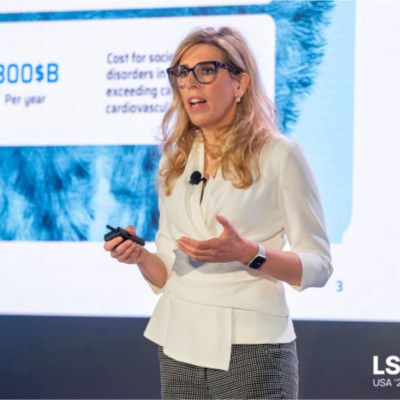- Video Library
- Carolina Aguilar, INBRAIN Neuroelectronics - Graphene Core Technology for the Brain | LSI USA '24
Carolina Aguilar, INBRAIN Neuroelectronics - Graphene Core Technology for the Brain | LSI USA '24

Carolina Aguilar
I’m a learner and a shaper, I like equally strategy and execution and believe on evolution through creativity and de-learning. I really get motivated by big challenges and like to execute in global environments. I believe in teams and the power of culture and collective thinking. People make companies and is the most important asset of all, a motivated team will conquer the world.
I have more than 15 years of expertise in healthcare (Medical Devices in Neuromodulation, Diabetes & others) in addition to consumer goods experience. Love to cross-pollinate ideas between the scientific and FMCG worlds.I realised soon the brain is one of our most important organs, the one that keep us human and sane and thus I have dedicated most of my time to it. Attracted by brain interfaces I joined the world's biggest Medtech, Medtronic, to lead the most advanced neural interface program at that time in Deep Brain Stimulation (DBS). For 10 years in DBS I managed complex businesses in this field and a P&L of more than $140M together with large local and global teams that generated high single to double digit growth % YOY. In recent years I got involved in Value Based Healthcare where I drove the expansion of the first VBHC provider model in Diabetes for Medtronic signing a major deal in Saudi Arabia and winning the European VBHC prize in 2017 amongst other milestones. (Diabeter, a Harvard Business School Case). Having implemented and expanded successfully such a major program, I understood the importance of delivering solutions driven by the outcomes that matter to patients as a means to patient empowerment and healthcare sustainability.
Having been for that long in the corporate side I decided it was time to make a key contribution to the speed of critical innovation and recently co-founded INBRAIN Neuroelectronics in the field of Bioelectronics with an incredible team coming from the nanoscience field, Medtronic and Philips. With VBHC principles, we are building the next generation of neural interfaces with graphene, a nobel prize winning material that allows high resolution and unparalleled targeting of the nervous system. We are a spin-off from Graphene Flagship's partner the Nanoscience & Nanotechnology Institute of Catalonia (ICN2). With the new physics graphene delivers, we are decoding brain and nerve signals into breakthrough and sustainable medical solutions!
Carolina Aguilar
I’m a learner and a shaper, I like equally strategy and execution and believe on evolution through creativity and de-learning. I really get motivated by big challenges and like to execute in global environments. I believe in teams and the power of culture and collective thinking. People make companies and is the most important asset of all, a motivated team will conquer the world.
I have more than 15 years of expertise in healthcare (Medical Devices in Neuromodulation, Diabetes & others) in addition to consumer goods experience. Love to cross-pollinate ideas between the scientific and FMCG worlds.I realised soon the brain is one of our most important organs, the one that keep us human and sane and thus I have dedicated most of my time to it. Attracted by brain interfaces I joined the world's biggest Medtech, Medtronic, to lead the most advanced neural interface program at that time in Deep Brain Stimulation (DBS). For 10 years in DBS I managed complex businesses in this field and a P&L of more than $140M together with large local and global teams that generated high single to double digit growth % YOY. In recent years I got involved in Value Based Healthcare where I drove the expansion of the first VBHC provider model in Diabetes for Medtronic signing a major deal in Saudi Arabia and winning the European VBHC prize in 2017 amongst other milestones. (Diabeter, a Harvard Business School Case). Having implemented and expanded successfully such a major program, I understood the importance of delivering solutions driven by the outcomes that matter to patients as a means to patient empowerment and healthcare sustainability.
Having been for that long in the corporate side I decided it was time to make a key contribution to the speed of critical innovation and recently co-founded INBRAIN Neuroelectronics in the field of Bioelectronics with an incredible team coming from the nanoscience field, Medtronic and Philips. With VBHC principles, we are building the next generation of neural interfaces with graphene, a nobel prize winning material that allows high resolution and unparalleled targeting of the nervous system. We are a spin-off from Graphene Flagship's partner the Nanoscience & Nanotechnology Institute of Catalonia (ICN2). With the new physics graphene delivers, we are decoding brain and nerve signals into breakthrough and sustainable medical solutions!

17011 Beach Blvd, Suite 500 Huntington Beach, CA 92647
714-847-3540© 2025 Life Science Intelligence, Inc., All Rights Reserved. | Privacy Policy







